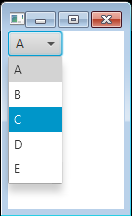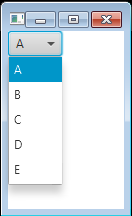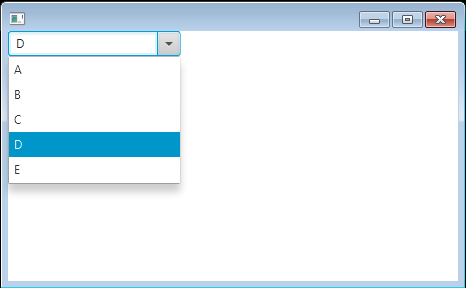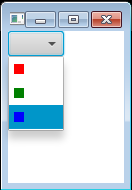JavaFX教程 - JavaFX组合框
组合框允许用户选择几个选项之一。用户可以滚动到下拉列表。组合框可以是可编辑和不可编辑的。
创建组合框
以下代码将选项列表包装到ObservableList中,然后使用observable列表实例化ComboBox类。
ObservableList<String> options =
FXCollections.observableArrayList(
"1",
"2",
"3"
);
ComboBox comboBox = new ComboBox(options);
我们还可以使用空构造函数创建一个组合框,并调用其setItems方法设置数据。
ComboBox comboBox = new ComboBox(options); comboBox.setItems(options);
向具有新值的项目的组合框中添加更多项目。
comboBox.getItems().addAll(
"4",
"5",
"6"
);
setValue 方法设置在组合框中选择的项目。在调用setValue方法时,即使值不在组合框项目列表中,selectionModel属性的选定项也会更改为此值。
getValue方法返回所选的值。
要限制下拉列表中可见行的数量,请使用以下代码。
comboBox.setVisibleRowCount(3)
可编辑的组合框
setEditable(true)方法使组合框可编辑。使用setPromptText方法,当不执行选择时,我们可以指定显示在组合框编辑区域中的文本。
ComboBox myComboBox = new ComboBox();
myComboBox.getItems().addAll(
"s@example.com",
"i@example.com",
"e@example.com",
"m@example.com"
);
myComboBox.setPromptText("Email address");
myComboBox.setEditable(true);
myComboBox.setOnAction((Event ev) -> {
address = myComboBox.getSelectionModel().getSelectedItem().toString();
});
myComboBox.setValue("s@example.com");
以下代码创建一个简单的可编辑组合框
import javafx.application.Application;
import javafx.scene.Group;
import javafx.scene.Scene;
import javafx.scene.control.ComboBox;
import javafx.stage.Stage;
public class Main extends Application {
public static void main(String[] args) {
launch(args);
}
@Override
public void start(Stage stage) {
Scene scene = new Scene(new Group(), 450, 250);
ComboBox<String> myComboBox = new ComboBox<String>();
myComboBox.getItems().addAll("A","B","C","D","E");
myComboBox.setEditable(true);
Group root = (Group) scene.getRoot();
root.getChildren().add(myComboBox);
stage.setScene(scene);
stage.show();
}
}
上面的代码生成以下结果。

组合框单元格
我们可以使用单元格工厂来改变组合框的默认行为或外观。
以下代码创建一个单元格工厂,并将其应用到组合框。
单元格工厂生成ListCell对象。 每个单元格与一个组合框项目相关联。
import javafx.application.Application;
import javafx.scene.Group;
import javafx.scene.Scene;
import javafx.scene.control.ComboBox;
import javafx.scene.control.ListCell;
import javafx.scene.control.ListView;
import javafx.scene.paint.Color;
import javafx.stage.Stage;
import javafx.util.Callback;
public class Main extends Application {
public static void main(String[] args) {
launch(args);
}
@Override
public void start(Stage stage) {
Scene scene = new Scene(new Group(), 200, 200);
ComboBox<String> myComboBox = new ComboBox<String>();
myComboBox.getItems().addAll("A", "B", "C", "D", "E");
myComboBox
.setCellFactory(new Callback<ListView<String>, ListCell<String>>() {
@Override
public ListCell<String> call(ListView<String> param) {
final ListCell<String> cell = new ListCell<String>() {
{
super.setPrefWidth(100);
}
@Override
public void updateItem(String item, boolean empty) {
super.updateItem(item, empty);
if (item != null) {
setText(item);
if (item.contains("A")) {
setTextFill(Color.RED);
} else if (item.contains("B")) {
setTextFill(Color.GREEN);
} else {
setTextFill(Color.BLACK);
}
} else {
setText(null);
}
}
};
return cell;
}
});
Group root = (Group) scene.getRoot();
root.getChildren().add(myComboBox);
stage.setScene(scene);
stage.show();
}
}
上面的代码生成以下结果。

例子
将值设置为null以清除ComboBox
import javafx.application.Application;
import javafx.scene.Group;
import javafx.scene.Scene;
import javafx.scene.control.ComboBox;
import javafx.stage.Stage;
public class Main extends Application {
public static void main(String[] args) {
launch(args);
}
@Override
public void start(Stage stage) {
Scene scene = new Scene(new Group(), 450, 250);
ComboBox<String> myComboBox = new ComboBox<String>();
myComboBox.getItems().addAll("A","B","C","D","E");
myComboBox.setValue("A");
System.out.println(myComboBox.getValue());
myComboBox.setValue(null);
Group root = (Group) scene.getRoot();
root.getChildren().add(myComboBox);
stage.setScene(scene);
stage.show();
}
}
上面的代码生成以下结果。

例2
设置和获取ComboBox的值
import javafx.application.Application;
import javafx.scene.Group;
import javafx.scene.Scene;
import javafx.scene.control.ComboBox;
import javafx.stage.Stage;
public class Main extends Application {
public static void main(String[] args) {
launch(args);
}
@Override
public void start(Stage stage) {
Scene scene = new Scene(new Group(), 450, 250);
ComboBox<String> myComboBox = new ComboBox<String>();
myComboBox.getItems().addAll("A","B","C","D","E");
myComboBox.setValue("A");
System.out.println(myComboBox.getValue());
Group root = (Group) scene.getRoot();
root.getChildren().add(myComboBox);
stage.setScene(scene);
stage.show();
}
}
上面的代码生成以下结果。

例3
将更改监听器添加到ComboBox valueProperty
import javafx.application.Application;
import javafx.beans.value.ChangeListener;
import javafx.beans.value.ObservableValue;
import javafx.scene.Group;
import javafx.scene.Scene;
import javafx.scene.control.ComboBox;
import javafx.stage.Stage;
public class Main extends Application {
public static void main(String[] args) {
launch(args);
}
@Override
public void start(Stage stage) {
Scene scene = new Scene(new Group(), 450, 250);
ComboBox<String> myComboBox = new ComboBox<String>();
myComboBox.getItems().addAll("A","B","C","D","E");
myComboBox.setValue("A");
System.out.println(myComboBox.getValue());
myComboBox.valueProperty().addListener(new ChangeListener<String>() {
@Override public void changed(ObservableValue ov, String t, String t1) {
System.out.println(ov);
System.out.println(t);
System.out.println(t1);
}
});
Group root = (Group) scene.getRoot();
root.getChildren().add(myComboBox);
stage.setScene(scene);
stage.show();
}
}
上面的代码生成以下结果。

例4
import javafx.application.Application;
import javafx.scene.Group;
import javafx.scene.Scene;
import javafx.scene.control.ComboBox;
import javafx.stage.Stage;
public class Main extends Application {
public static void main(String[] args) {
launch(args);
}
@Override
public void start(Stage stage) {
Scene scene = new Scene(new Group(), 450, 250);
ComboBox<String> myComboBox = new ComboBox<String>();
myComboBox.getItems().addAll("A","B","C","D","E");
myComboBox.setEditable(true);
myComboBox.setPromptText("Email address");
Group root = (Group) scene.getRoot();
root.getChildren().add(myComboBox);
stage.setScene(scene);
stage.show();
}
}
上面的代码生成以下结果。

例5
在ComboBox中显示矩形
import javafx.application.Application;
import javafx.scene.Group;
import javafx.scene.Scene;
import javafx.scene.control.ComboBox;
import javafx.scene.layout.GridPane;
import javafx.scene.paint.Color;
import javafx.scene.shape.Rectangle;
import javafx.stage.Stage;
public class Main extends Application {
public static void main(String[] args) {
Application.launch(args);
}
@Override
public void start(final Stage primaryStage) {
Group root = new Group();
Scene scene = new Scene(root, 400, 300, Color.WHITE);
GridPane gridpane = new GridPane();
ComboBox<Rectangle> cmb = new ComboBox<Rectangle>();
cmb.getItems().addAll(
new Rectangle(10, 10, Color.RED),
new Rectangle(10, 10, Color.GREEN),
new Rectangle(10, 10, Color.BLUE));
gridpane.add(cmb, 2, 0);
root.getChildren().add(gridpane);
primaryStage.setScene(scene);
primaryStage.show();
}
}
上面的代码生成以下结果。

例6
以下代码显示了如何使用CellFactory显示组合框值。
//Revised from javafx api document
import javafx.application.Application;
import javafx.scene.Group;
import javafx.scene.Scene;
import javafx.scene.control.ComboBox;
import javafx.scene.control.ContentDisplay;
import javafx.scene.control.ListCell;
import javafx.scene.control.ListView;
import javafx.scene.layout.GridPane;
import javafx.scene.paint.Color;
import javafx.scene.shape.Rectangle;
import javafx.stage.Stage;
import javafx.util.Callback;
public class Main extends Application {
public static void main(String[] args) {
Application.launch(args);
}
@Override
public void start(final Stage primaryStage) {
Group root = new Group();
Scene scene = new Scene(root, 400, 300, Color.WHITE);
GridPane gridpane = new GridPane();
ComboBox<Color> cmb = new ComboBox<Color>();
cmb.getItems().addAll(Color.RED, Color.GREEN, Color.BLUE);
cmb.setCellFactory(new Callback<ListView<Color>, ListCell<Color>>() {
@Override
public ListCell<Color> call(ListView<Color> p) {
return new ListCell<Color>() {
private final Rectangle rectangle;
{
setContentDisplay(ContentDisplay.GRAPHIC_ONLY);
rectangle = new Rectangle(10, 10);
}
@Override
protected void updateItem(Color item, boolean empty) {
super.updateItem(item, empty);
if (item == null || empty) {
setGraphic(null);
} else {
rectangle.setFill(item);
setGraphic(rectangle);
}
}
};
}
});
gridpane.add(cmb, 2, 0);
root.getChildren().add(gridpane);
primaryStage.setScene(scene);
primaryStage.show();
}
}
上面的代码生成以下结果。


 免费AI编程助手
免费AI编程助手



更多建议: